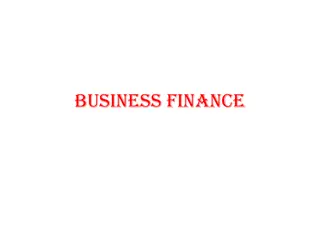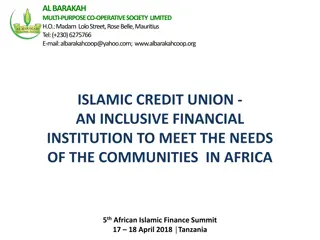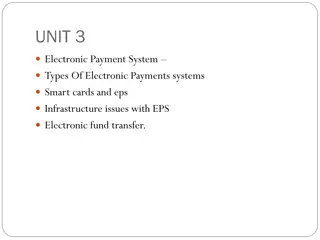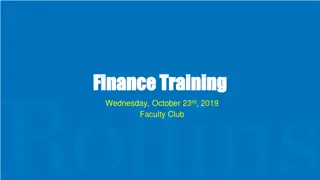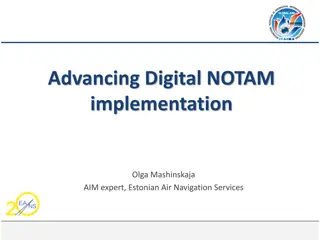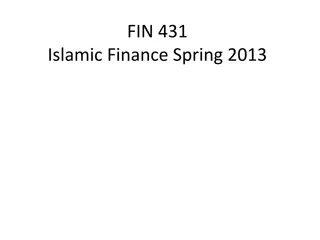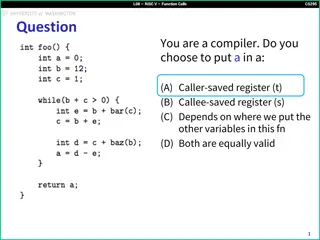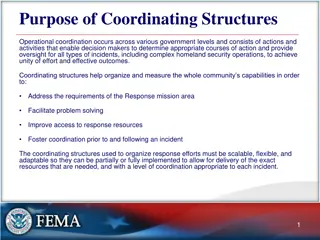The Evolution of Finance Function Structures in the Digital Era
Explore the changing landscape of finance function structures in the digital age, from hierarchical shapes to shared services and outsourcing. Learn about the importance of organizational structure and different types of structures like entrepreneurial, functional, divisional, and matrix. Dive into how organization structure guides work division and role allocation to enhance efficiency and decision-making within finance functions.
Download Presentation

Please find below an Image/Link to download the presentation.
The content on the website is provided AS IS for your information and personal use only. It may not be sold, licensed, or shared on other websites without obtaining consent from the author. Download presentation by click this link. If you encounter any issues during the download, it is possible that the publisher has removed the file from their server.
E N D
Presentation Transcript
Managing Finance in a Digital World Chapter 3: The Structure & Shape of the Finance Function
Organisational Structure The Structure & Shape of the Finance Function Learning Outcome Learning Outcome D1. Describe the structure & shape of the Finance Function Component D1) Describe the: a) b) Structure of the Finance function from the roles that generate information to the roles that turn information into insight & communicate insight to decision makers. Hierarchical shape of the Finance function. Shared services & outsourcing of Finance operations. Retained Finance. Automation & diamond shape of Finance function . Evolution of the shape of the Finance Function Shape of the Finance function in the Digital Era
Organisational Structure The Structure & Shape of the Finance Function Importance of Organisation Structure Defines/guides how work and Importance of Organisation Structure work is is divided and responsibilities divided up up and and allocated allocated, outlines the roles outlines the roles responsibilities of individuals and groups within the organisation. Mintzberg s Effective Organisation 1. Strategic Apex Individuals who formulate and implement strategy, execute mission to serve owners. Simple Structure 2. Middle Line Heirarchy of authority linking strategic apex with front line surpervisors (operating core). Divisional Form 3. Operating Core Those responsible for producing the product or providing the service. Professional Bureacracy 4. Technostructure Co-ordinate the work by standardising processes, outputs and skills (HR, Accountants, Industrial Engineers). Machine Beauracry 5. Support Staff Provide assistance outside of operational workflow (catering, legal advice). Adhocracy Ideology Culture (values and beliefs) of behaviour. Missionary
The Structure & Shape of the Finance Function Types Types of of Structure Structure: : 1 1. . ENTREPENURIAL ENTREPENURIAL Built Built around around owner/manager owner/manager. . Typical Typical for for small small business business 2 2. . FUNCTIONAL FUNCTIONAL Employees Employees grouped grouped into into task task orientated orientated departments departments
The Structure & Shape of the Finance Function 3 3. . DIVISIONAL Each DIVISIONAL Organisation Each division Organisation split treated as as a a profit split into centre (Strategic into divisions (Strategic Business divisions focused Business Unit focused on on product, Unit - - SBU) product, geography SBU) geography or or customer customer. . division treated profit centre 4 4. . MATRIX MATRIX Combination Combination of of function function & & divisional divisional dual dual reporting reporting streams streams. .
The Structure & Shape of the Finance Function Another way of analysing structures is by reference to the degree of autonomy or the level at which decisions are made i.e. Centralised The upper level of an organisation s hierarchy retain the authority to make decisions Centralised Structure Structure Decentralised The authority to make decisions is passed down to units & people at lower levels. Decentralised Structure Structure Factors Factors affecting affecting the the amount amount of of (de)centralisation (de)centralisation: : 1. Management Style 2. The ability of management/employees 3. Geographical spread 4. The size of the organisation
Advantages of decentralisation Senior management free to concentrate on strategy Better local decisions due to local expertise Better motivation due to increased empowerment of employees & a more defined career path Quicker responses/flexibility due to reduced bureaucracy & increased autonomy Disadvantages of decentralisation Dysfunctional decisions due to a lack of goal congruence Loss of control by senior management & lack of standardisation Poor decisions made by inexperienced managers Training costs Duplication of roles within organisation Extra costs in obtaining information since it is stored in several locations
Tall vs Flat Structures Definition: Scalar chain The line of authority which can be traced up or down the chain of command. It is the number of levels of management within an organisation. Definition: Span of control Number of people for whom he or she is directly responsible.
Boundaryless Structures Boundaryless organisations (contemporary model of structure) - unstructured design not constrained by a chain of command or formal departments, which focuses on flexibility. Hollow organisations Hollow organisations split their functions into core (i.e. strategically and non-core activities. Anything which is classified as non- to other organisations. Virtual (network) organisations Organisation outsources many of its functions to other organisations and simply exists as a network of contracts, with very few, if any, functions being kept in- house. Usually exists electronically on the internet, without any physical premises Modular organisations Example of structure for boundaryless manufacturing companies. Break the manufacturing process into modules or components. Each component can then be made by the company or outsourced to an external supplier. important) core is outsourced
Alliances Types of Alliances: 1. Joint Ventures Forming a separate business entity 2. Strategic Alliances Contractual agreements for sharing of resources & activities across two or more organisation to pursue strategies. No separate entity is formed. 3. Franchising Purchase of right to exploit a business brand in exchange for value 4. Licenses Right to exploit an invention or resource in exchange for value 5. Consortia- Short-term legal entities to deliver a particular project 6. Agents- Distribution channel where local knowledge and contacts are important Shamrock Organisation Handy(2002) defines the shamrock organisation as a core of essential executives & workers supported by outside contractors & part-time help. Structure permits the buying in of services as needed, with consequent reductions in overhead costs.
Contemporary Transformation of Finance Function Historically, the overall mandate of the Finance function was to focus on organisational efficiencies & to reduce operational costs. Technology has replaced this, with machines being capable of monitoring operational costs & patterns of organisational efficiency. Technology allows the contemporary finance function to refocus its energy to revenue & value creation. The finance function will no longer work in isolation but will work with other across the organisation to drive business transformation that creates shareholder value.
Contemporary Transformation of Finance Function The Finance function will need to built new competences but it is well positioned to meet this changing mandate since:
Information to Impact Framework Technology & automation will have the largest impact on the assembly and analysis activities. This will freeup the resource of the finance function professionals who can now place greater focus on the advising and applying/executing activities
Theevolving Shape of Finance Function The shape is migrating from: 1. A hierarchical triangle (traditional shape) 2. To a segregated triangle (last 20 years) 3. And finally to the diamond shape (today s digital age)
Why the shape of Finance Function is changing The changing mandate for finance Technology Finance function capability Will the shape of Finance Function continue to evolve The shape will continue to evolve & finance will no longer be just for pure accountants. There will be an increasing emphasis on professional level roles requiring support and management skills. There will be a continued emphasis on specialist knowledge leading to the formation of multi-disciplinary teams who will become members of the finance team.
Outsourcing Outsourcing - contracting out of aspects of the work of an organisation, previously done in- house, to specialist providers. An organisation usually outsources its non-core activities e.g. facility management, hr, cleaning services, legal services, etc .This allows an organisation to focus on their core competences. These are not outsourced as doing so would erode competitive advantage. Offshoring - the relocation of corporate activities to a foreign country
Outsourcing Outsourcing Service Level Agreement Service level agreement (SLA) is the negotiated legal agreement between the supplier and the customer regarding the level of service to be provided. It includes: A detailed explanation of what service the supplier is offering Expected response time to technical queries Expected time to recover the operations in the event of a disaster Procedure for dealing with complaints The information and reporting procedures to be adopted The procedure for cancelling the contract Transaction Cost Theory indirect expenses incurred in outsourcing. Bargaining costs Search, information and assessment costs to identify supplier Policy and enforcement costs Transaction Cost theory - Williamson and Coarse. Page 73 74 of text book.
Outsourcing the Finance Function This is becoming increasingly common & the emphasis has been on reducing costs but outsourcing has also enabled the retained finance function to focus on strategic change by working more closely with the business to provide business partnering to help improve decision making. Finance function activities that can be outsourced? Transactional processes Statutory & regulatory accounting, Financial reporting & tax, Management accounting, Budgeting & forecasting. Benefits Drawbacks Cost reduction Radical Transformation Access to superior capabilities, expertise & resources of the specialist provider Business partnering Loss of control Outsourcing will cause disruption & may result in significant resistant to change Risk of intellectual property theft & data breaches Erosion of internal knowledge & skills Transaction costs- expertise, time & money in managing outsourced services. 20
Shared Service Centre: Finance Function Shared Service Approach Restructuring the provision of certain services within the organisation so that instead of the service being found in several different parts of the organisation it is consolidated into one specific part of the organisation. Also known as Internal Outsourcing. SSC have become a well established model for organisations to drive efficiencies, improve compliance & controls & enable insight into the business Change towards SSCs is being driven by: Globalisation Advances in Information Technology Benefits of establishing a SSC Cost Reduction Opportunity to standardize processes An improved level of service A better opportunity to compare trends across the organization Consolidation of systems
Offshoring Shared Service Centre: Finance Function Risks associated with establishing a SSC Has the organization got the resources needed to spread the major set up costs? Employee issues. Lack of systems integration across the organization may make migration of diverse systems complicated, costly & time consuming. A SSC is often established in a MNC. The complexities of the countries that its operating in including different laws, languages, cultures & reporting may make this difficult Alternative to establishing a SSC for the Finance Function: An option can be to establish a SSC but rather than the service being provided inhouse a decision is taken to outsource the provision of the shared services to a third party who specializes in the provision of such services SSC whether in-house or operated by a service provider (outsourced) have industrialised the provision of routine management and accounting services but now offer scope to expand vertically to offer higher value services.
















